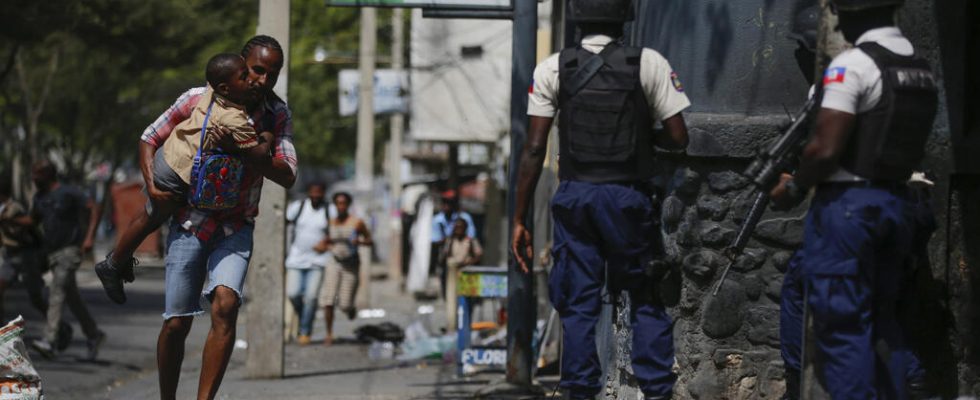Haitian Prime Minister Ariel Henry has arrived in Kenya and hopes to be able to take advantage of his visit to sign with the Head of State William Ruto a “ reciprocity agreement » allowing the deployment of the Multinational Security Support Mission in Haiti. Nairobi agreed to take the lead in helping the Haitian police fight against gangs. The project was suspended by a court decision but a bilateral agreement could resolve the situation.
5 mins
Diego Da Rin is an expert at the International Crisis Group. According to him, a signing of an agreement would be an important step but not the last obstacle to the deployment of international troops in Haiti…
Diego Da Rin : This is the main obstacle for Kenya to be able to send these thousand police officers and lead this mission. There is another which concerns the funds and equipment of the different countries wishing to contribute to the mission. Kenya said that until all the funds needed to send the mission were available, it would not send the police officers to Haiti.
RFI: Kenya has warned that it needs 600 million dollars.
Yes, the figures vary slightly depending on the sources but this one was presented to the Parliament of Kenya when the project was submitted by the government. Some diplomats find this figure a little high compared to real needs, but it is the amount that is publicly requested by Kenya.
And we are far from it today ?
The United States has said it will provide $200 million for the operation, but the U.S. Congress has yet to approve the contribution. There was also a meeting in Brazil on the sidelines of the G20 a few days ago, during which it seems that more than 120 million was collected. These contributions would therefore amount to more or less half of the 600 million required. So, it’s not yet won.
And then there is also the question of personnel. You told us, Kenya plans to send a thousand men to Haiti. Jamaica, the Bahamas, other South American countries are also expected to participate. That represents a few hundred people. And we learned at the beginning of the week that Benin offered to mission 2 000 soldiers. Is this enough, in your opinion? ?
Still according to the report submitted by the Kenyan government to its Parliament to present the deployment project, Haiti had initially requested a force of 1,500 police officers. So, with the 1,000 Kenyan police officers, the 2,000 from Benin… which is a country with French as its official language, so it’s important: at least, this time, there is this awareness that we must ‘a good part of the staff speaks at least French. Some of the Kenyan police officers to be mobilized have also started having French lessons since October. So, with the contributions of certain Caribbean countries, we could arrive at a force of more or less 4,000 personnel. If everyone is specially trained for urban combat and is well equipped, then the force could change the balance of power between the Haitian security forces and the gangs in the short term.
You write in your last report on Haiti, it is important that the force is imposing from the start.
Indeed, the gangs are waiting to see what this mission will look like. These groups particularly fear a force that would have at its disposal equipment that they do not have, such as armed troop transport vehicles or helicopters.
Your organization conducted interviews in Haiti and we can read in your latest report that the gangs seem to be considering two possible responses to the arrival of the multinational mission : negotiations, if they were really dominated by force, but if not, they could come together in a coalition and choose violence.
We saw in September that the two main coalitions operating in the capital – a coalition of gangs – wanted to erase their differences, in particular to prepare for a possible deployment of a foreign force in Haiti. This non-aggression pact lasted very little, but we have information indicating that communications are still ongoing between rival gangs. So the possibility exists of seeing some sort of united front between gangs. But if the multinational force really represented a threat, which they felt they could not confront successfully, there are already quite influential leaders who have said they are ready to negotiate with a view to possible demobilization.
There are discussions between the different gangs, and then, there is another risk which could limit the effectiveness of this multinational force, and that is the collusion which exists between the gangs and certain police officers.
Absolutely. This is going to be one of the main obstacles, at different levels of the police hierarchy because – not only is there some collusion between fairly high-ranking members of the police and certain gangs – but also there are police officers, who have just joined the institution and who live in quite complicated neighborhoods, sometimes right next to neighborhoods controlled by gangs, and are forced to collaborate with them in one way or another. So, it will be very important that the foreign force works in particular with the special units which have been subject to careful personnel screening to ensure that they are not in collusion with the gangs and thus avoid any leak of information about their operations. But, to ensure that these results will last over time, it is necessary, for example, to significantly increase the capacity of the Haitian police. It has fewer than 10,000 active police officers for a population of twelve million people. By international standards, Haiti should have around 25,000 active police officers, more than double the current number.
Read alsoUN calls for $674 million in humanitarian aid for Haiti
